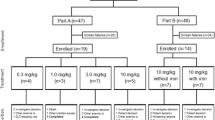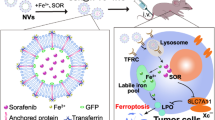Abstract
Transferrin receptor (TfR) has been used as a target for the antibody-based therapy of cancer due to its higher expression in tumors relative to normal tissues. Great potential has been shown by anti-TfR antibodies combined with chemotherapeutic drugs as a possible cancer therapeutic strategy. In our study, we investigated the anti-tumor effects of anti-TfR monoclonal antibody (mAb) alone or in combination with sinomenine hydrochloride in vitro. Results suggested that anti-TfR mAb or sinomenine hydrochloride could induce apoptosis, inhibit proliferation, and affect the cell cycle. A synergistic effect was found in relation to tumor growth inhibition and the induction of apoptosis when anti-TfR mAb and sinomenine hydrochloride were used simultaneously. The expression of COX-2 and VEGF protein in HepG2 cells treated with anti-TfR mAb alone was increased in line with increasing dosage of the agent. In contrast, COX-2 expression was dramatically decreased in HepG2 cells treated with sinomenine hydrochloride alone. Furthermore, we demonstrated that the inhibitory effects of sinomenine hydrochloride and anti-TfR mAb administered in combination were more prominent than when the agents were administered singly. To sum up, these results showed that the combined use of sinomenine hydrochloride and anti-TfR mAb may exert synergistic inhibitory effects on human hepatoma HepG2 cells in a COX-2-dependent manner. This finding provides new insight into how tumor cells overcome the interference of iron intake to survive and forms the basis of a new therapeutic strategy involving the development of anti-TfR mAb combined with sinomenine hydrochloride for liver cancer.




Similar content being viewed by others
References
Jone DT, Trowbridge IS, Harris AL (2006) Effects of transferrin receptor blockade on cancer cell proliferation and hypoxia-inducible factor function and their differential regulation by ascorbate. Cancer Res 66:2749–2756
Daniels TR, Delgado T, Helguera G, Penichet ML (2006) The transferrin receptor part II: targeted delivery of therapeutic agents into cancer cells. Clin Immunol 121:159–176
Habashy HO, Powe DG, Staka CM, Rakha EA, Ball G, Green AR et al (2010) Transferrin receptor (CD71) is a marker of poor prognosis in breast cancer and can predict response to tamoxifen. Breast Cancer Res Treat 119:283–293
Rodríguez JA, Luria-Pérez R, López-Valdés HE, Casero D, Daniels TR, Patel S et al (2011) Lethal iron deprivation induced by non-neutralizing antibodies targeting transferrin receptor 1 in malignant B cells. Leuk Lymphoma 52:2169–2178
Huang RK, Steinmetz NF, Fu CY, Marianne Manchester M, Johnson JE (2011) Transferrin-mediated targeting of bacteriophage HK97 nanoparticles into tumor cells. Nanomedicine 6:55–68
Daniels TR, Ortiz-Sanchez E, Luria-Perez R, Quintero R, Helguera G, Bonavida B et al (2011) An antibody-based multifaceted approach targeting the human transferrin receptor for the treatment of B-cell malignancies. J Immunother 34:500–508
Qing Y, Shuo W, Zhihua W, Huifen Z, Ping L, Lijiang L et al (2006) The in vitro antitumor effect and in vivo tumor-specificity distribution of human–mouse chimeric antibody against transferrin receptor. Cancer Immunol Immunother 55:1111–1121
Shen X, Zhu HF, He FR, Xing W, Li L, Liu J et al (2008) An anti-transferrin receptor antibody enhanced the growth inhibitory effects of chemotherapeutic drugs on human non-hematopoietic tumor cells. Int Immunopharmacol 8:1813–1820
Peng JL, Wu S, Zhao XP, Wang M, Li WH, Shen X et al (2007) Downregulation of transferrin receptor surface expression by intracellular antibody. Biochem Biophys Res Commun 354:864–871
Tao J, Tu YT, Li JW, Feng AP, Huang CZ, Wu Y et al (2006) Endogenous production of nitric oxide contributes to proliferation effect of vascular endothelial growth factor-induced malignant melanoma cell. Clin Exp Dermatol 31:94–99
Ferrara N, Gerber HP, LeCouter J (2003) The biology of VEGF and its receptors. Nat Med 9:669–676
Liu Y, Tao J, Li Y, Yang J, Yu Y, Wang M et al (2009) Targeting hypoxia-inducible factor-1 alpha with Tf-PEI-shRNA complex via transferrin receptor-mediated endocytosis inhibits melanoma growth. Mol Ther 17:269–277
Huang WJ, Xia LM, Zhu F, Huang B, Zhou C, Zhu HF et al (2009) Transcriptional upregulation of HSP70-2 by HIF-1 in cancer cells in response to hypoxia. Int J Cancer 124:298–305
Yamasaki H (1976) Pharmacology of sinomenine, an anti-rheumatic alkaloid from Sinomenium acutum. Acta Med Okayama 30:1–20
Jin HZ, Wang XL, Wang HB, Wang YB, Lin LP, Ding J et al (2008) Morphinane alkaloid dimers from Sinomenium acutum. J Nat Prod 71:127–129
Wang Q, Li XK (2011) Immunosuppressive and anti-inflammatory activities of sinomenine. Int Immunopharmacol 11:373–376
Kok TW, Yue PY, Mak NK, Fan TP, Liu L, Wong RN (2005) The anti-angiogenic effect of sinomenine. Angiogenesis 8:3–12
Ju XD, Deng M, Ao YF, Yu CL, Wang JQ, Yu JK et al. (2010) Protective effect of sinomenine on cartilage degradation and chondrocytes apoptosis. Yakugaku Zasshi 130:1053–1060
Jiang T, Zhou L, Zhang W, Qu D, Xu X, Yang Y et al (2010) Effects of sinomenine on proliferation and apoptosis in human lung cancer cell line NCI-H460 in vitro. Mol Med Rep 3:51–56
Du H, Xiang J, Zhang Y, Tang Y (2007) A spectroscopic and molecular modeling study of sinomenine binding to transferring. Bioorg Med Chem Lett 17:1701–1704
Chen W, Shen Y, Zhao GS, Yao HP (2004) Inhibitory effect of sinomenine on expression of cyclooxygenase-2 in lipopolysaccharide-induced PC-12 cells. Zhongguo Zhong Yao Za Zhi 9:900–903
Jung YJ, Isaacs JS, Lee S, Trepel J, Neckers L (2003) IL-1β-mediated up-regulation of HIF-1α via an NFκB/COX-2 pathway identifies HIF-1 as a critical link between inflammation and oncogenesis. FASEB J 17:2115–2117
Yao L, Liu F, Hong L, Sun L, Liang S, Wu K et al (2011) The function and mechanism of COX-2 in angiogenesis of gastric cancer cells. J Exp Clin Cancer Res 30:13
Lei P, He Y, Ye Q, Zhu HF, Yuan XM, Liu J et al (2007) Antigen-binding characteristics of AbCD71 and its inhibitory effect on PHA-induced lymphoproliferation. Acta Pharmacol Sin 28:1659–1664
Kawamoto M, Horibe H, Kohno M, Kawakami K (2011) novel transferrin receptor-targeted hybrid peptide disintegrates cancer cell membrane to induce rapid killing of cancer cells. BMC Cancer 18:359
Wang SJ, Sun B, Cheng ZX, Zhou HX, Gao Y, Kong R et al (2011) Dihydroartemisinin inhibits angiogenesis in pancreatic cancer by targeting the NF-κB pathway. Cancer Chemother Pharmacol 68:1421–1430
Nagy VM, Buiga R, Brie I, Todor N, Tudoran O, Ordeanu C et al (2011) Expression of VEGF, VEGFR, EGFR, COX-2 and MVD in cervical carcinoma, in relation with the response to radio-chemotherapy. Rom J Morphol Embryol 52:53–59
Raspollini MR, Amunni G, Villanucci A, Boddi V, Taddei GL (2006) COX-2 and preoperative CA-125 level are strongly correlated with survival and clinical responsiveness to chemotherapy in ovarian cancer. Acta Obstet Gynecol Scand 85:493–498
Tsujii M, Kawano S, Tsuji S, Sawaoka H, Hori M, DuBois RN (1998) Cyclooxygenase regulates angiogenesis induced by colon cancer cells. Cell 93:705–716
Daniel TO, Liu H, Morrow JD, Crews BC, Marnett LJ (1999) Thromboxane A2 is a mediator of cyclooxygenase-2-dependent endothelial migration and angiogenesis. Cancer Res 59:4574–4577
Liang RY, Cao LY, Wang WJ, Liu XY, Wang PX (2007) Studies on anti-inflammatory mechanism of sinomenine. J Guang Zhou Univ Tradition Chin Med 24:141–143
Wang WJ, Wang PX (2002) Selective inhibitory effect of sinomenine on activity of cyclooxygenase 2. J Guang Zhou Univ Tradition Chin Med 19:46–51
Acknowledgments
We thank Yue Zhang and Shuang Zou for their kind assistance in this study. This work was supported by funding from the National Natural Science Foundation of China (No. 81102531 to Xin Shen), the Important National Science and Technology Specific Projects (2009ZX09301-014 to Guanxin Shen), and the Young Foundation of Hubei Provincial Department of Education (Q20101804 to Yi Hong).
Conflict of interest
The authors declare that they have no conflict of interest.
Author information
Authors and Affiliations
Corresponding author
Additional information
Yi Hong and Juan Yang contributed equally to the study and share first authorship.
Rights and permissions
About this article
Cite this article
Hong, Y., Yang, J., Shen, X. et al. Sinomenine hydrochloride enhancement of the inhibitory effects of anti-transferrin receptor antibody-dependent on the COX-2 pathway in human hepatoma cells. Cancer Immunol Immunother 62, 447–454 (2013). https://doi.org/10.1007/s00262-012-1337-y
Received:
Accepted:
Published:
Issue Date:
DOI: https://doi.org/10.1007/s00262-012-1337-y




